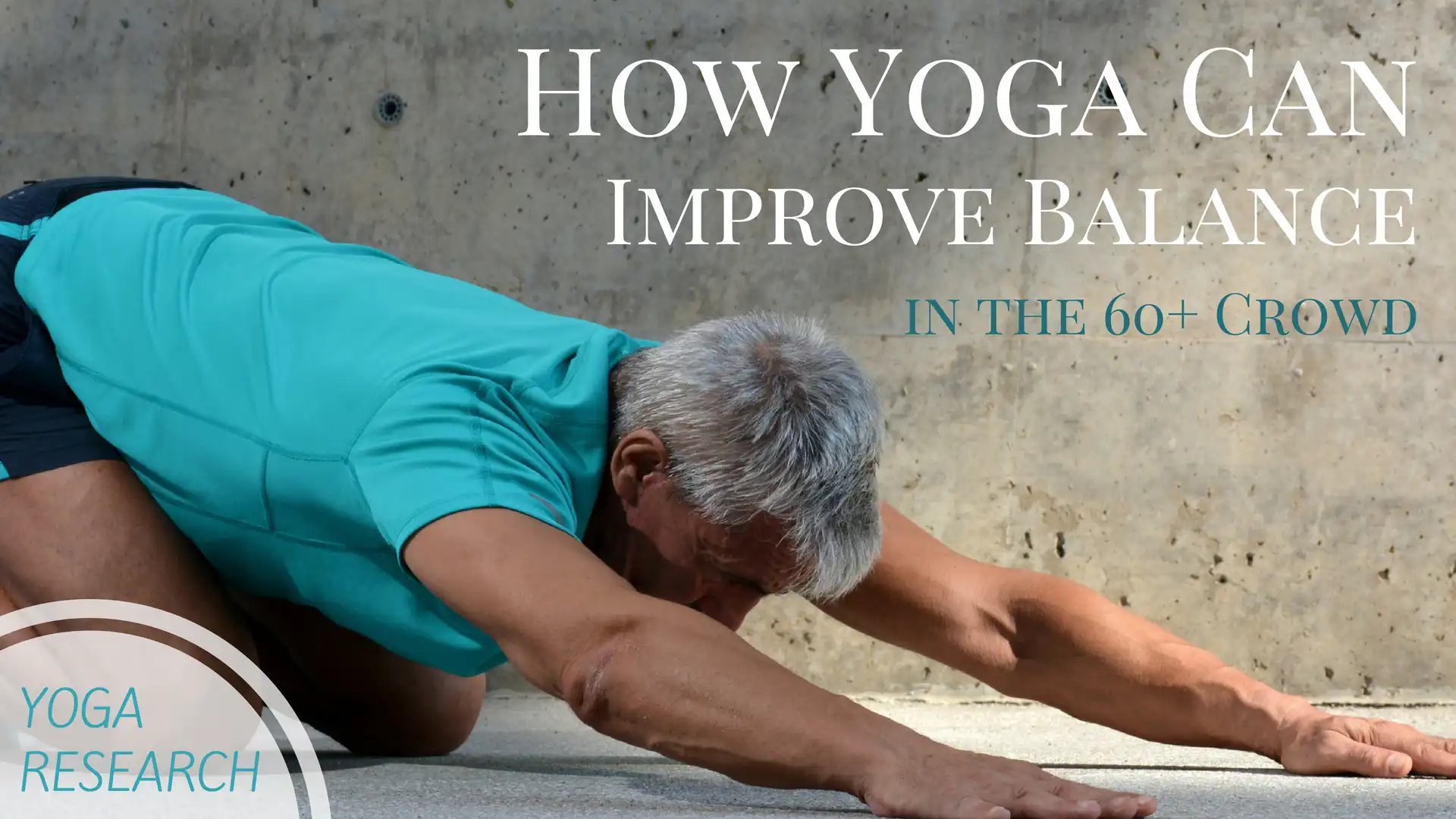Yoga Research: New Studies Show that Yoga Can Improve Balance in the 60-and-Over Crowd

Aging is associated with a number of changes in the physical body and one of them is a reduced ability to balance. Most people in the general population fail to attach importance to the ability to balance, but they should, especially as they grow older. As we age, our ability to balance declines, which can cause falls.
Every year more than one in three people age 65 years or older fall, and the risk increases with age. A simple fall can cause a serious injury to the hip, pelvis, spine, arm, hand or ankle that will require hospitalization, disability, or loss of independence and sometimes even death.
How Do Our Bodies Maintain Balance?
Balance is the ability to distribute our weight to enable us to hold a steady position, turn easily, or move without falling. The ability to balance is determined by a complex combination of muscle strength, specific areas of the brain, visual and vestibular systems, and the nerves of joints, muscles, ligaments, and tendons that orient you in a defined space.
The vestibular system inside our ears is one of the main balance centers that detects where our bodies are in space. Whether we are upright, as in Tadasana (Mountain Pose); lying flat as in Savasana (Relaxation Pose); standing on our feet as in Virabhadrasana I and II (Warrior I and II Poses); or upside down, as in Sirsasana (Headstand Pose) the ability to perceive our orientation is controlled by the vestibular system. The vestibular system cross-talks with specific areas in the brain to determine our stability and whether any corrective action should be taken.
How Aging Affects Balance
As we age, cells in the vestibular system degenerate, resulting in failure to detect our position in space. This affects our ability to correct any imbalances. As an example, if we happen to tilt more to the right and the vestibular system doesn’t detect this quickly, it becomes harder for the brain to take corrective measures to prevent falling to the right.
In addition to the vestibular system, the visual system also helps with balance. Our sight, including the ability to focus, and the ability to see things clearly, diminishes as we age. Furthermore, our perception of depth, night vision, and sensitivity to contrast also fail as we age. These problems can impair, blur or distort vision, all of which compromise balance.
Circulatory and cardiac issues that accompany the aging process also affect balance. The problems show up as changes in blood pressure that can dip suddenly when you stand up, causing dizziness, lightheadedness, blurry vision, and even fainting.
As we age, we lose muscle mass and strength and with it, the power to react swiftly, which ultimately affects balance. Our reflexes and coordination also slow down with age.
Other co-morbidities that accompany the aging process can interfere with balance. They include, but are not limited, to Parkinson’s disease, osteoarthritis, stroke, and multiple sclerosis. In addition, several medications prescribed for the above-mentioned health issues may also increase the risk of falls. The medications may damage the inner ear or trigger blurred vision, dizziness, lightheadedness, and drowsiness, all of which can result in balance issues.
How Yoga Practice Can Help Us Maintain Balance 
But scientific studies have shown that yoga can help! In The influence of tai chi and yoga on balance and falls in a residential care setting: A randomized controlled trial, yoga has been shown to improve balance.
Another study from Australia that fetched a lot of media attention evaluated the feasibility and effectiveness of a group-based yoga program compared with the usual care among people aged 60 and over. The pilot study, involving 54 people aged 60, was designed in preparation for another more detailed trial to determine if yoga prevents falls among older people.
While one-half of the participants participated in a twice-weekly Iyengar yoga class for 12 weeks, the other half read an information booklet on fall prevention. At the end of the 12 weeks, the researchers compared the two groups on their ability to complete some functional tests of balance and mobility.
The researchers found that the group that took part in yoga practice could perform significantly faster in tests involving standing and sitting down quickly without using their arms for support. The yoga group also walked significantly faster in a walking test and could stand on one leg for longer, indicating improved balance. The yoga program was also found to be safe and fun for the older participants and attendance was very good.
Thus, the above studies demonstrated the potential impact that yoga may have on improving balance and reducing fall risk. In general, an asana practice that includes strength, flexibility, and a wide variety of balancing poses will help to maintain balance as we age.
Learn more about this topic-study with Baxter Bell, MD, and YogaUOnline: Yoga for Core Integrity and Balance.
Also, read more on yoga and balance from YogaUOnline writer, Jennifer Williams-Fields – Yoga for Balance Training: Why Static Poses Don’t Cut It.
Reprinted with permission from Yoga for Healthy Aging.
 Ram Rao, Ph.D. With a doctorate in Neuroscience, Ram presently serves as a Research Associate Professor at the Buck Institute for Research on Aging. He focuses on various aspects of age-associated neurodegenerative diseases with emphasis on Alzheimer’s disease. In addition, Ram completed the academic training at the California College of Ayurveda (CCA) and received his certification as Clinical Ayurvedic Specialist. He has been a faculty of the California College of Ayurveda and teaches in their Nevada City location. Ram is also a dedicated Hatha yoga practitioner and is a Registered Yoga Teacher from Yoga Alliance USA. In his spare time, he offers consultations in YAMP techniques (Yoga, Ayurveda, Meditation & Pranayama). Ram has published several articles in major Yoga/Ayurveda magazines and has been a featured speaker in several national and international meetings and symposia. He is a member of the National Ayurvedic Medical Association (NAMA) and is on the Research Board of the Association of Ayurvedic Professionals of North America (AAPNA).
Ram Rao, Ph.D. With a doctorate in Neuroscience, Ram presently serves as a Research Associate Professor at the Buck Institute for Research on Aging. He focuses on various aspects of age-associated neurodegenerative diseases with emphasis on Alzheimer’s disease. In addition, Ram completed the academic training at the California College of Ayurveda (CCA) and received his certification as Clinical Ayurvedic Specialist. He has been a faculty of the California College of Ayurveda and teaches in their Nevada City location. Ram is also a dedicated Hatha yoga practitioner and is a Registered Yoga Teacher from Yoga Alliance USA. In his spare time, he offers consultations in YAMP techniques (Yoga, Ayurveda, Meditation & Pranayama). Ram has published several articles in major Yoga/Ayurveda magazines and has been a featured speaker in several national and international meetings and symposia. He is a member of the National Ayurvedic Medical Association (NAMA) and is on the Research Board of the Association of Ayurvedic Professionals of North America (AAPNA).


